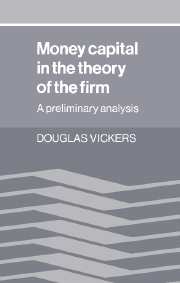Book contents
- Frontmatter
- Contents
- Preface
- PART I Theoretical issues and analytic motivation
- PART II The neoclassical tradition
- 4 Production, pricing, investment, and financing interdependence in the firm
- 5 Probability, risk, and economic decisions
- 6 Utility, uncertainty, and the theory of choice
- 7 Financial asset markets and the cost of money capital
- 8 The cost of money capital: further analysis and controversy
- 9 The investment expenditure project
- PART III Postclassical perspectives
- References
- Index
9 - The investment expenditure project
Published online by Cambridge University Press: 18 September 2009
- Frontmatter
- Contents
- Preface
- PART I Theoretical issues and analytic motivation
- PART II The neoclassical tradition
- 4 Production, pricing, investment, and financing interdependence in the firm
- 5 Probability, risk, and economic decisions
- 6 Utility, uncertainty, and the theory of choice
- 7 Financial asset markets and the cost of money capital
- 8 The cost of money capital: further analysis and controversy
- 9 The investment expenditure project
- PART III Postclassical perspectives
- References
- Index
Summary
The cost of money capital, understood in one or another of the ways examined in the preceding chapter, serves as a criterion of the economic worthwhileness of investing in the firm. The addition of money capital to the firm, or the retention within it of the money capital that presently exists and may be transferable to other economic uses, may depend, of course, on a number of considerations. Investment may be made in order to protect or increase market shares and in anticipation of economic growth, to effect cost reductions or take advantage of technological change, or to maximize the size of the firm because of the benefits that might thereby accrue to the management. But wisdom dictates, when account is taken of the long-run viability and economic position of the firm, that regard should be paid to the fact that money capital is a scarce resource and that a cost has to be paid for its employment. A balance should be struck between that cost and the economic values or benefits that the employment of money capital can generate.
Investment decision criterion
The basic notations relevant to money capital investment decisions were encountered in Chapter 3. The investment decision requires, in the terms summarized there, that the prospective increment of economic value be no less than the amount of marginal money capital it is proposed to employ.
- Type
- Chapter
- Information
- Money Capital in the Theory of the FirmA Preliminary Analysis, pp. 180 - 188Publisher: Cambridge University PressPrint publication year: 1987



